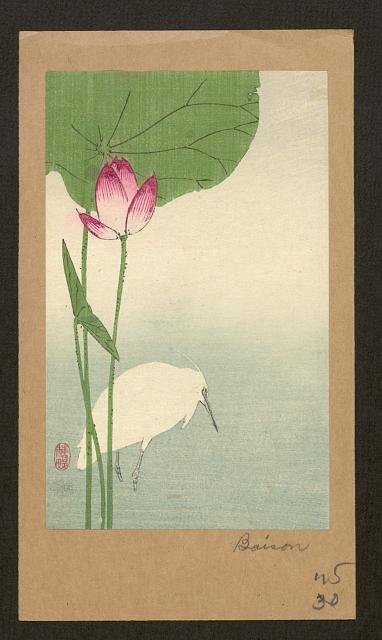
Image is from the Library of Congress, Prints and Photographs: Japanese prints and drawings.
Not so amazing, but fascinating nonetheless is this fact: beautiful plants and flowers not typically known as vegetables were discovered in ancient cultures to have healing properties in all their parts. Seeds, stems, roots, leaves, flowers and fruits and less fleshy parts such as seed capsules, bark or coverings, parts of roots or rhizomes, etc. all have specific application to illnesses or acute and painful bodily conditions.
The Lotus is a mystical water-dwelling plant, offering a return to health for seekers of relief from heart ache, bleeding disorders, diarrhea, and skin afflictions. Its actions on the bodily systems are known to be astringent, stiptic, blood-moving, cooling and calming. Chinese medicine has long revered the Lotus: it has been eaten and used to treat illness for thousands of years. It has this mystical status because of its beauty and form, rising above the water and mud in which it grows, and producing seeds and fruit that benefit humans.
The practice of Traditional Chinese Medicine emphasizes the role of food and nutrition. Together with appropriate life choices, it is nutrition that creates the bodily conditions for optimal health to re-achieved once disorders or diseases have ravaged our once perfectly-working systems.
Perhaps we don’t realize how much managing our health depends on the quality and kind of food we enjoy. So we put healthy choices on our plates but think about medicinal substances as pills from plastic containers, i.e., a laboratory. We think that eating and taking medicine are separate, but from the Asian viewpoint, food is medicine.
Dr. Henry C. Lu, a practitioner and scholar has written extensively on the confluence of food and herbs as medicinal agents. His work, Chinese Natural Cures was published by Black Dog and Leventhal Publishers, New York, 2005 (c1986); it treats the philosophy and diagnosis of disease with discussion, lists and tables, defining herbs and foods that provide relief and tonic properties. One of these herbal medicines is listed as the flower from Nelumbo nucifera, for bleeding disorders; as food, its root, seed and fruit are tonic to the spleen, also heart and kidneys, and its stem used for internal heat, summer heat, and diarrhea. Similar prescriptions, although much more precise as to dosage and results, are given in Chinese Herbal Medicine Materia Medica Revised Edition, compiled and translated by Dan Bensky and Andrew Gamble, Eastland Press Inc., 1993 (c1986).
Another manual was reproduced from the Chinese classic, Ben cao gang mu; the book in English is Chinese Medicinal Herbs A Modern Translation of a Classic Sixteenth Century Manual. / Li Shih-Chen. Translated and Researched by F. Porter Smith and G.A. Stuart, published by Dover Publications, 2003. Utilizing a dictionary format, the plants are described under their botanical names and listed alphabetically, with sidebar notation for the common name in use at the time this translation was completed. Nelumbium speciosum is the scientific name given to our Lotus with a common name of “East Indian Lotus”. The book’s treatment of Nelumbium (Nelumbo) species enumerates the Chinese name for the whole plant and also for its parts, displaying the Chinese characters alongside Smith’s and Stuart’s translations compiled in 1973.
Lotus flowers, stems, seeds, leaves and roots are celebrated in Asian cultures. Lotus seeds and roots are taken in Ayurvedic and Chinese medicinal preparations. This ancient wisdom is derived from other works and translations of the Shen-Nung P’en Tsao, a treatise on medicines written in China about 600 A.D. It inherited the literary tradition of works on how to treat disease that began in written form about six hundred years earlier in the Huang-Ti Nei-Jing or Yellow Emperor’s Classic of Internal Medicine.
Lotus’s association with spirituality is ancient, and may have been the reason for its use as both food and medicine. In Buddhism the icon represents purity. The Lotus is also symbolic of wealth and plentitude and spirituality represented by the Hindu goddess Lakshmi.



